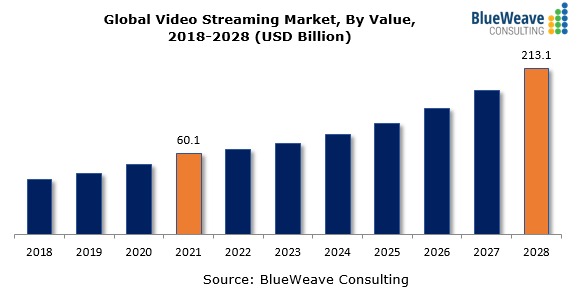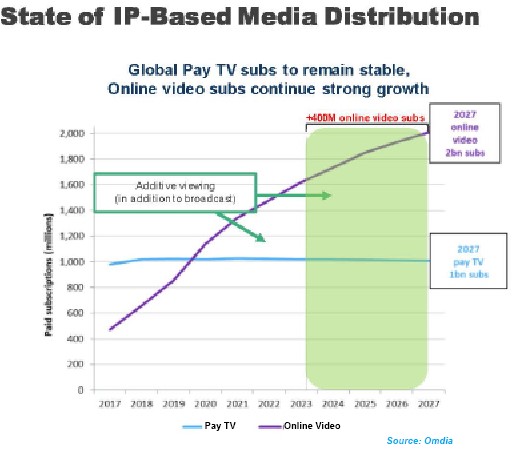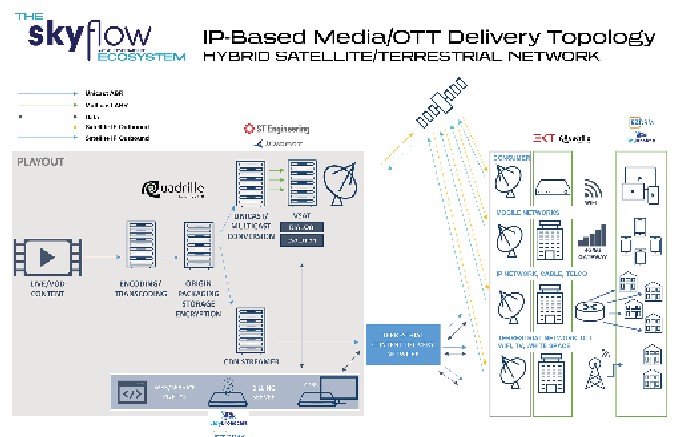OTT Solutions for the Changing Video Market
by Elisabeth Tweedie
Los Angeles, Calif., April 12, 2024 - According to the latest statistics from Cloudflare, global internet traffic increased by 25% in 2023, and there are no signs that this growth is about to slow down. Data from Cisco indicates that 82% of this traffic is video, a reflection, at least in part, of the continuing shift in consumer viewing habits. The move to Over-the-Top (OTT) streaming video started many years ago in developed countries. In the US the crossover occurred in 2016 when the number of subscribers to streaming services surpassed the number of subscribers to traditional pay TV. This year will see the revenue crossover point, when both streaming services and traditional pay TV in the US will earn around US$17 billion.
 |
Looking ahead, according to Omdia, traditional pay TV subscriptions around the world, are predicted to remain stable to 2027, at around one billion. Paid subscriptions to streaming media, on the other hand are predicted to continue their rapid growth, adding another 400 million subscribers between 2023 and 2027. This however fails to take into account the rapid growth in Free Advertising-supported Streaming TV (FAST) and Advertising supported Video-on-Demand (AVOD), the two segments of streaming services experiencing the most growth. Data from Amagi indicates that year-on-year growth (quarter 4 2022 to quarter 4 2023) in hours of viewing of FAST channels, increased by 130% in Asia Pacific, 64% in Latin America, 65% in Europe, Middle East and Africa (EMEA). In the US where 47% of viewers already watch FAST channels, Amagi is reporting only 5% growth.
Nevertheless, an article in Variety stated that FAST would overtake traditional subscription streamed services as the preferred viewing method in North America by 2030. This year revenue from advertising supported services in the US is expected to be US$9 billion, over half of total streaming revenue.
The leading subscription video-on-demand (SVOD) providers, are not sitting idly by watching their customers devote some of their viewing hours to other channels. They are creating their own AVOD and FAST channels in addition to the SVOD channels. Viewing on FAST channels consists mainly of content that was first aired on traditional linear channels, making these channels easy to create for both established and new players in the streaming market place. Unlike traditional VOD, which is file-based delivery, the vast majority of FAST channels are linear channels, further complicating the delivery mechanism, as the same internet connection into the home, needs to be able to simultaneously deliver a linear channel, alongside multiple file-based programs or movies for the VOD viewers in a household.
Easy creation is one thing, easy delivery is entirely another! In many parts of the world – even in developed countries – there are areas where the terrestrial internet bandwidth, is simply inadequate for streamed video. In addition, legacy delivery mechanisms for streamed video do not scale, leading to a poor user experience. To date there has been no integrated end-to-end OTT satellite solution. Given that traditional pay TV is not going away any time soon (video still accounts for 52% of Eutelsat’s revenue, and as already mentioned, satellite and cable TV paid subscriptions are projected to remain flat at one billion subscribers for the next few years) service providers are faced with needing to deliver both satellite and an ever-increasing number of both OTT linear and VOD channels.
Not just Consumer Video
 |
Video streaming was a US$69.89 billion business in 2022, but almost half of this is accounted for by enterprise video. There is no doubt that Covid and lockdowns helped drive an uptake of this service. Not only did video meetings and live training sessions become the norm, delivery of file-based training and education became a necessity. Sadly, particularly for education, this sudden necessity for remote learning highlighted disparities around the world. For some children, the technology was there. They lived in developed areas where high bandwidth to the home was readily available. In other regions, this was absolutely not the case. According to UNICEF at the beginning of the pandemic, nearly five hundred million children around the world had no access to distance learning.[1] This disparity in access, not only impacts education and future development in those regions, it also impacts healthcare. Without access to the internet, or in some cases even television, during Covid, basic healthcare messages didn’t get out. People weren’t aware that congregating in large groups facilitated the spread of the virus. This led to more illness and higher death rates in those regions. Peru was the most extreme example of this. Not only did 30% of the population, have no viable distance learning platform, the National Institute of Radio and Television of Peru (IRTP) did not have the means to communicate public health news effectively. Largely as a result of these two factors, Peru had the highest death rate per 100,000 population in the world.[2]
SKYflow
Fortunately, thanks to ingenuity of engineers at ST Engineering iDirect, and its partners, it is now possible to deliver file-based video, linear streaming video and traditional live TV all at the same time. Unicast, simply doesn’t scale. If four people in one location are all watching the same 4K video streams, each requiring 25 Mbps, then a 100 Mbps internet stream must be reliably and consistently available to that household, or enterprise, in order to ensure an adequate user quality of experience (QoE).
SKYflow successfully combines traditional satellite multicast digital video broadcast (DVB) to a TV, utilizing MPEG-TS, with OTT unicast service, utilizing MPEG-DASH and Apple HLS. The former is highly scalable and delivers a high QoE, but without any personalization or possibility of using catchup TV or VOD. The latter offers both of those, coupled with personalized IP content. However, it doesn’t scale, has limited reach and offers an inferior QoE when compared to traditional DVB over satellite.
 |
By combining the best features of both of these delivery methods, into Satellite Multicast ABR, SKYflow delivers a scalable service with expanded reach, offering a high QoE, including personalized IP content and catchup TV and VOD. SKYflow utilizes a hybrid satellite - terrestrial network to create an IP- based Media/OTT delivery system.
ST Engineering iDirect’s partners for SKYflow are, Easy Broadcast, EKT, EZDRM and Quadrille. Easy broadcast provides the content management system and service backend, including billing for the headend side of the system. EKT, provides a low-cost set top box (STB) that can receive the video feed directly from the satellite (or a VSAT if a return path is needed), it also provides the demodulation and encapsulation and converts the multicast stream to a unicast stream for WiFi distribution in the home or enterprise. EZDRM provides the digital rights management (DRM) system and Quadrille provides the content delivery network (CDN) and delivers the unicast ABR stream to OTT players, and the HDMI stream to TV sets via the STB from Easy Broadcast. ST Engineering iDirect provides the encapsulation and modulation to facilitate native IP (NIP) over satellite.
DVB-NIP
DVB-NIP is “secret sauce” that makes SKYflow so ubiquitous. The standard was developed by the Digital Video Broadcast (DVB) group of which ST Engineering iDirect is a leading member. The DVB-NIP standard, bridges the gap between broadcast and broadband networks facilitating a truly converged media distribution solution. It takes the efficiency of multicast broadcast networks and integrates the broadcast technologies into broadband networks.
Applications
Applications that benefit from SKYflow DVB-NIP go far beyond consumer video. It facilitates remote education and distance learning with on-demand delivery of e-books, papers, exams etc., as well as live and VOD lessons to schools and homes using cost-effective satellite infrastructure. A return path can easily be set up via the VSAT. In other words, it is a major step in closing the digital divide and opening education to all. A clear example of this is demonstrated by the way SKYflow has been used to improve both education and the distribution of public service information in Peru. During the pandemic, as already mentioned, the IRTP realized that they had no means of effectively communicating vital public health news and information via the existing public broadcast network. Neither were they able to provide a distance learning platform to the 30% of the population without internet connectivity. SKYflow with DVB-NIP was the solution. Now, every household in Peru will have access to DTH content as well as educational media.
This is particularly relevant for those households that don’t have internet connectivity, but do have a television, tablet or smart phone. SKYflow facilitates delivery of content directly to those devices, via the STB in the home.
e-learning is forecast to grow at a 20% CAGR through 2028 to reach a market size of US$325 billion.
Once viewed as way to get away from all, cruises are now viewed as a way to take it all with you – at least as far as connectivity is concerned!
Passengers no longer accept slow connections and high fees. They now expect to be able to live stream their experiences to friends back home, send videos, download movies and play interactive games. Cruise lines have taken this to heart, and broadband connectivity is now marketed as a major onboard attraction. But buying the satellite bandwidth to provide this connectivity to thousands of passengers is expensive. This is where SKYflow and DVB-NIP can help. NIP over satellite provides a more efficient way of using the existing bandwidth. It provides an augmented video experience to both passengers and crew using less bandwidth than other technologies.
Crew members of commercial shipping lines also want broadband access, to keep in touch with family and similarly enjoy access to a variety of on demand files, movies and live services. A recent survey found that connectivity was the most important factor for 33% of crew surveyed, being ranked above pay and leave entitlement. During Covid, many crew members found themselves stuck onboard, out of reach of connectivity for many months, far beyond their usual voyage time. Largely as a result of this, the Maritime Labor Convention (MLC) has now been updated, to give seafarers the mandatory right to internet access. Once again DVB-IP and SKYflow, can help deliver this economically for the shipping company.
In the air, is another location where passengers want to take their at home connectivity experience with them. The logistics of delivering this experience to users at 33,000 feet traveling at around 600mph can be challenging to say the least. DVB-NIP can help reduce the inability of customers to connect to and maintain a video service link throughout their flight. As Alex Beach, Head of Media and Broadcast said:” Native IP over satellite can help solve the persistent problem of connectivity in the air. On board an aircraft accessible broadband is often of very low standard and often unable to support video streaming. Airlines can now assure their passengers that they will be able to access the content of their choice, in-flight. A key differentiator in a highly competitive market.”
The hospitality industry, particularly sports bars and boutique hotels (where customers are provided with a tablet instead of cable or satellite TV in their room), is another sector where SKYflow could significantly improve the service offered to customers. In these locations, WiFi networks can easily become overloaded, leading to buffering and therefore a poor QoE for the customer. Here NIP works as a complement to terrestrial broadband and can provide both linear and VOD content via satellite. As Annamaria Recchia, VP Commercial Development, Marketing & Product Video, Eutelsat, said: “Consumers experience network congestion from poor WiFi or broadband connectivity in hospitality venues, so there is a real interest for providers to be able to enhance this user experience and to bring video content to places such as hotels, bars and restaurants. When it comes down to it, satellite has always been, and it still is, a golden medium to distribute live video.”
Other applications that could benefit from DVB-IP and SKYflow include next generation Direct-to-home (DTH) services. These networks will distribute OTT content as well as linear satellite TV as already mentioned. As well as extending coverage to customers in remote areas, SKYflow will facilitate delivery of DTH content to laptops, tablets and smartphones, as well as the main TV screen.
KYflow can also be used to create remote hotspots in areas where reliable terrestrial infrastructure is not available. Integrated smart algorithms ensure that the delivery is always managed so as to prioritize the most watched/needed videos and data.
It is also ideal for offloading of mobile networks. Operators can complement their 5G service with satellite. They can benefit from satellite’s inherent multicast capabilities for new applications, such as software delivery for connected cars. Equally a mobile operator could utilize satellite to facilitate the build out of 5G to remote areas, where it would be cost prohibitive to extend the terrestrial infrastructure.
Government and Defense are other areas that could benefit from utilizing SKYflow, particularly for troop morale – giving them access to OTT services whilst away from home and providing access to welfare services and two-way video to connect to family and friends.
 |
| MCX8000 Multi-Carrier Satellite Gateway |
MCX8000 Multi-Carrier Satellite Gateway
Initially designed to increase the efficiency of DTH services and improve the user QoE, it is now also used for distribution-to-towers (DTT) and OTT distribution. The gateway is a high-density, high availability, fully redundant modular system. It reduces downtime and simplifies operations with two hot-swappable modem modules, hot swappable power supply units and an integrated 1+1 redundancy switch. All hot-swappable modules can be removed without any special tools. These features enable simple upgrade or downgrade to any configuration by the easy addition or removal of any module.
“...Other applications that could benefit from DVB-IP and SKYflow include next generation Direct-to-home (DTH) services. These networks will distribute OTT content as well as linear satellite TV...”
For DTH, using proprietary technology, the MCX8000 facilitates squeezing the maximum throughput out of the available bandwidth, regardless of whether DVB-S, DVB-S2X is being used. It supports SMPTE 2022-7 Seamless Protection Switching to provide a reliable transport stream.
The MCX8000 also reduces the amount of bandwidth needed for OTT distribution to headends. The Content Delivery Network (CDN) is able to reduce the traffic on the distribution backbone by receiving only a single copy of a program at the edge. SKYflow then converts this into multiple copies for onward delivery to the consumer on demand. This is particularly effective for live events, popular movies or series.
The gateway is also used as a satellite front-end to feed multiple Integrated Receiver Decoders (IRDs) for Distribution to Towers (DTT) also known as Digital Terrestrial Television. The MCX8000 receives multiple MPEG-2 transport streams from one or more transponders using DVB2-S2X. It extracts those transport streams and feeds them over ASI or IP into the IRDs.
The MCX8000 is also the ecological choice for service providers. Its reduced power consumption and efficient use of bandwidth combine to make it 38% more efficient than traditional delivery mechanisms.
Given that traditional payTV is going to be around for many years yet, and OTT video streaming is projected to have a CAGR of 20% for the next eight years to become a US$310.71 billion by 2030 the need for DVB-IP and SKYflow is obvious!
---------------
Notes:
[1] https://data.unicef.org/resources/remote-learning-reachability-factsheet/
[2] https://data.unicef.org/resources/remote-learning-reachability-factsheet/
------------------------------
 Elisabeth Tweedie is Associate Editor of the Satellite Executive Briefing and has over 20 years experience at the cutting edge of new communications and entertainment technologies. She is the founder and President of Definitive Direction (www.definitivedirection.com), a consultancy that focuses on researching and evaluating the long-term potential for new ventures, initiating their development, and identifying and developing appropriate alliances. She can be reached at: etweedie@definitivedirection.com
Elisabeth Tweedie is Associate Editor of the Satellite Executive Briefing and has over 20 years experience at the cutting edge of new communications and entertainment technologies. She is the founder and President of Definitive Direction (www.definitivedirection.com), a consultancy that focuses on researching and evaluating the long-term potential for new ventures, initiating their development, and identifying and developing appropriate alliances. She can be reached at: etweedie@definitivedirection.com





